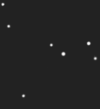Fairly bright, easy to locate and perfect to be seen
in binoculars, C73 or NGC1851 is a class II globular cluster (GC) in the
southern constellation of Columba. Being a class II GC means that is has a
fairly compact core which is precisely why it is bright enough for binoculars.
If Charles Messier would have access a couple of degrees south of his location,
I could see NGC1851 in his list of “like comets” DSOs.
Columba is a small constellation neighbor of the well
known Canis Majoris, where Sirius resides. If one connects the dots (stars) is
the right way and with some imagination, it would certainly resembles a colibri,
but its name means dove in Latin so let’s say it looks like a landing dove.
The globular is
couple of arc degrees south-west from Phact,a 2nd magnitude and the alpha star
of Columba. Under my Bortle 5 skies it was easy to find in binoculars and it
looked like a fuzzy round ball with some fuzz around.
Definitely a good
target to catch in the south even with a pair of binoculars.
Happy hunting,
LG
Edited by: Jennifer
Steinberg (editor in chief).



No comments:
Post a Comment